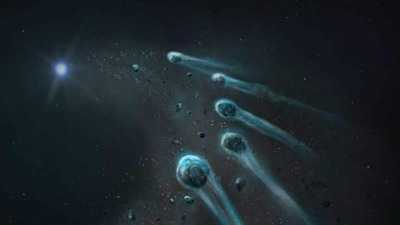
Astronomers discover a unique icy planetesimal: What's so special?
28 Sep 2025
Astronomers from the University of Warwick have discovered a frozen and water-rich planetary fragment being consumed by a white dwarf star.
The finding was published in the Monthly Notices of the Royal Astronomical Society.
The research team used ultraviolet spectroscopy from the Hubble Space Telescope to analyze distant stars' chemical composition and identify this unique icy object.
Discovery of volatile-rich atmosphere
Unique find
Among the stars studied, one star, WD 1647+375, stood out because of its "volatile" elements on the surface.
Unlike typical white dwarf atmospheres that are mostly hydrogen and helium, this star had carbon, nitrogen, sulfur, and oxygen.
The discovery of this volatile-rich atmosphere was the first indication that WD 1647+375 was different from other stars in its class.
'Cosmic crime scenes'
Stellar analysis
Lead author Snehalata Sahu explained that white dwarfs often show signatures of elements like calcium and iron from the material they absorb.
This material comes from planets and asteroids that get too close to the star.
By analyzing this chemical composition, researchers can learn about the composition of planetesimals outside our solar system.
Sahu likened white dwarfs to "cosmic crime scenes," where elements left by an accreted planetesimal provide clues about its identity.
Evidence of icy origin
Chemical fingerprint
The ultraviolet spectroscopy revealed that the material acquired by WD 1647+375 had a high nitrogen content, indicating an icy planetesimal.
This is the highest nitrogen abundance ever detected in a white dwarf's debris.
The star's atmosphere also contained more oxygen than expected for a rocky object, further supporting the idea of an icy origin.
Possible comet or dwarf planet fragment
Planetary composition
The data suggests that the object being consumed by this star is an icy/water-rich planetesimal, possibly a comet like Halley's or a fragment of a dwarf planet.
The second author of the study, Professor Boris T. Gansicke, said the volatile-rich nature of WD 1647+375 is similar to Kuiper-belt objects in our solar system, and suggests it could be a fragment of a Pluto-like planet.
Importance of the discovery
Ongoing investigation
The discovery of this icy planetesimal is the first clear case of a hydrogen-atmosphere white dwarf absorbing such an object. However, it remains unclear whether this body originated in the planetary system around the original star or was an interstellar comet captured from deep space.